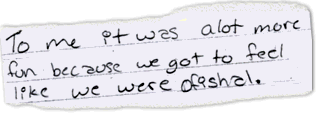Dig Journal
Before going out on the dig, students met with Andrea Richardson to set up the format for recording their information in their journals. During the dig process, whenever students found an artifact, they sketched the exact location, uncovered the entire floor at that 10 cm increment and then put the artifact into a paper bag labeled with the unit number, quadrant and level. At the conclusion of each day, students returned to the classroom to complete reflections and analyze their observations.
The two classes compared their journal entries and discussed the experience of being on an archeological dig. Here is what the students think it is important to know.
Our dig was hard and fun. On the first day of the dig it was easy and hard because there was no clay at the top of the dirt so it was easy to dig but we had to work as a group and that [can be] hard.
In our group there were three people. It was a lot funner having three people than four so it wasn’t so crowded like some groups and each of us had a quadrant and a bit. I think that it was easier to dig the SE quadrant [the quadrant left over] because you could see where every level was because of where the layers were in the other quadrants. It was also easier to get the levels flat because we could just stick our trowel down 10 cm. Some groups found it was hard to make the levels flat and the walls straight because of all the roots. The funnest part of the dig was when we found artifacts.
I learned to dig like an archaeologist. We learned we have to go slowly and carefully so we don’t break anything. I found that the dig was a lot different than just exploring the area. To me, it was a lot more fun because we got to feel like we were official. On Level 1, we found pottery, nails, barb wire and wood. On Level 2, we were supposed to find a big metal surprise because the metal detector beeped loudly, but we dug and found nothing . I thought for sure we’d find something, but we didn’t. Our group worked well. We had lots of fun and we hope we get to dig next year. |



 We dug to level 2 the first day and there were video cameras taping
us the whole time. I enjoyed the fame but it’s like you can never
get any time without them following you. [The second] day of digging
was easier because we knew what to do and how to do it. We found a lot
of pretty neat and old stuff but nothing that really caught our eye.
We were working
all day using the sifter, digging, carrying heavy
buckets, being on camera, breaking roots.
We dug to level 2 the first day and there were video cameras taping
us the whole time. I enjoyed the fame but it’s like you can never
get any time without them following you. [The second] day of digging
was easier because we knew what to do and how to do it. We found a lot
of pretty neat and old stuff but nothing that really caught our eye.
We were working
all day using the sifter, digging, carrying heavy
buckets, being on camera, breaking roots.  The sifting was the hardest part. We had to stand in line with our pail
of dirt and wait until the million people in front of us had sifted through
their pail first. Although we knew sifting was important, we didn’t
find any smaller objects as we sifted. Being so official for so long
a time is hard.
The sifting was the hardest part. We had to stand in line with our pail
of dirt and wait until the million people in front of us had sifted through
their pail first. Although we knew sifting was important, we didn’t
find any smaller objects as we sifted. Being so official for so long
a time is hard.